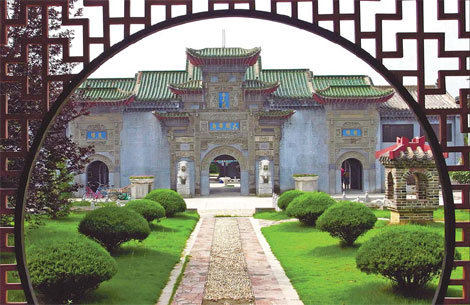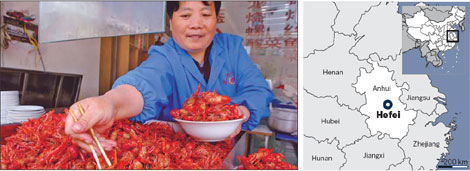|
 |
|
Hefei is a city of gardens, featuring typical Hui-style architecture with white walls and elaborate woodcarving. Zhang Yanlin / Asia News Photo
|
 |
|
Crayfish is one of the best known delicacies in Hefei. Wu Fang / Asia News Photo
|
The capital of Anhui province is blessed with rivers, lakes, cultural and historical attractions. Tan Zongyang reports.
'Two obese people get married. Guess the name of the Chinese city."
The answer to the riddle is Hefei, as he means put together, and fei means fat.
The capital of Eastern China's Anhui province, Hefei is at the junction of Dongfei and Nanfei rivers, which is how it got its name.
Hefei has many historical and cultural sites, such as the Memorial Temple of Lord Bao, the famously honest and upright official Bao Zheng (999-1062).
The former residence of Li Hongzhang (1823-1901), a leading statesman during the late Qing Dynasty (1644-1911), is located on Huaihe Road in the city's bustling downtown area.
Hefei is known as a garden city because of its many parks, which include Belt Park, a "green necklace" that circles the old town.
Peking Opera developed from Hui Opera, which first appeared in Anqing, Anhui, more than 300 years ago. It combines traditional Chinese theater with music, vocal performances, mime, dancing and acrobatics.
Hui Opera flourished and spread all over the country, fascinating Beijing and a series of emperors in the Qing Dynasty.
During the reign of Emperor Jiaqing (1796-1820), four Hui Operas troupes arrived in the capital and were a sensation.
The regional opera gradually developed into Peking Opera after it was performed in the Beijing dialect and combined with Han, Kun and other operas.
Hui Opera has a distinctive dance and vocal style, is visually exciting and has spectacular stage settings. The costumes are simple and tasteful.
Nowadays, Hui Opera lacks funding and talented players, but in Hefei, home to the Anhui Provincial Hui Opera Troupe, established in 1956, you can still experience the authentic opera.
The troupe performs its repertoire once or twice every month in the city's Huijing Theater. Just make a call to the theater (0551-2634-340) and make sure of the date and time of the show.
One of the most famous dining options in Beijing has its counterpart in Hefei, but with the additional flavor of Anhui cuisine.
Luzhou roast duck was originally served to the royal court. Until the Ming Dynasty (1368-1644), this recipe was a secret of royal or rich family kitchens, but it gradually leaked out and became a favorite of the populace.
The duck's tender meat and thin, crispy skin is less fatty and salty than Beijing roast duck.
Home to many rivers and lakes, such as one of the country's largest freshwater lakes, Chaohu, Hefei is blessed with abundant aquatic products. The city is one of the country's major producers of crayfish, known locally as "small lobster".
You can find the delicacy on "Crayfish Street". The best-known local food court is on Ningguo Road and has about 20 restaurants serving crayfish cooked in a variety of styles.
Most of the crayfish restaurants are open until midnight, while some open until dawn.
As the province's capital, Hefei is an important railway network and aviation hub that is a great stepping off point for Anhui's other attractions, such as Huangshan and Jiuhua mountains, Hongcun and Xidi villages.
Hefei is 10 hours from Beijing by train.
By Tan Zongyang (China Daily)
|